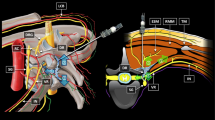Abstract
Purpose
Puncture of the skin by a needle, such as for peripheral nerve block or for intravenous or arterial catheter placement, may cause pain to the patient, so that analgesic method may be required to reduce pain caused by needle puncture. Nevertheless, there is little information as to which puncture sites are more painful than the other.
Methods
After obtaining an approval of the study by a research ethics committee and written informed consent from all the participants, we studied 30 volunteers to quantify pain threshold at 13 skin sites of the body, using an algometer.
Results
Compared with pain threshold at the cubital fossa (which was regarded as the control value), the relative pain threshold was significantly lower (with clinically meaningful difference) at the lateral carpus (median (interquartile range): 0.66 (0.56–0.73)) and the medial carpus (0.80 (0.73–0.94)); and was significantly higher (with clinically meaningful difference) at the olecranon (2.08 (1.93–2.42)), the forehead (1.59 (1.46–1.74)), the upper shoulder (1.52 (1.38–1.79)), and the dorsal shoulder (1.39 (1.18–1.55)).
Conclusions
We conclude that there are significant differences in pain threshold between different puncture sites. Analgesic method before needle puncture may be required at the sites where the pain threshold is relatively low.


Similar content being viewed by others
Data availability
Data are available from the authors.
References
Mashu S, Shibaji T, Zeredo JL. Comparison of mechanical pain thresholds among various orofacial areas in human. Pain Res. 2004;19:123–31.
Park S, Roh SH, Lee JY. Body regional heat pain thresholds using the method of limit and level: a comparative study. Eur J App Physiol. 2019;119:771–80.
Park MY, Han D, Lim JH, Shin MK, Han YR, Kim DH, Rhim S, Kim KS. Assessment of pressure pain thresholds in collisions with collaborative robots. PlosOne. 2019;2(14):e0215890.
Hardy JD, Wolff HG, Goodell H. Pricking pain threshold in different body areas. Proc Soc Exp Biol Med. 1952;80:425–7.
De Paepe AL, Williams ACC, Crombez G. Habituation to pain: a motivational-ethological perspective. Pain. 2019;160:1693–7.
Pud D, Golan Y, Pesta R. Hand dominancy - a feature affecting sensitivity to pain. Neurosci Lett. 2009;467:237–40.
Yousef H, Alhajj M, Sharma S. Anatomy, skin (integument), epidermis. StatPearls publishing LLC: 2022. https://www.statpearls.com/point-of-care/21212.
Lauria G, Holland N, Hauer P, Cornblath DR, Griffin JW, McArthur JC. Epidermal innervation: changes with aging, topographic location, and in sensory neuropathy. J Neurol Sci. 1999;164:172–8.
McArthur JC, Stocks EA, Hauer P, Cornblath DR, Griffin JW. Epidermal nerve fiber density: normative reference range and diagnostic efficiency. Arch Neurol. 1998;55:1513–20.
Staud R, Price DD, Robinson ME, Vierck CJ Jr. Body pain area and pain-related negative affect predict clinical pain intensity in patients with fibromyalgia. J Pain. 2004;5:338–43.
Racine M, Tousignant-Laflamme Y, Kloda LA, Dion D, Dupuis G, Choinière M. A systematic literature review of 10 years of research on sex/gender and experimental pain perception - part 1: are there really differences between women and men? Pain. 2012;153:602–18.
Duan G, Xiang G, Zhang X, Guo S, Zhang Y. An improvement of mechanical pain sensitivity measurement method: the smaller sized probes may detect heterogeneous sensory threshold in healthy male subjects. Pain Med. 2014;15(2):272–80.
Funding
None
Author information
Authors and Affiliations
Contributions
KM: This author made the study conception and design, proposal writing, data management, analysis and interpretation, as well as drafting and approving the final version of the manuscript. TA: This author helped in the study conception and design, proposal writing, data management analysis and interpretation, as well as writing and approving the final version of the manuscript. Funding: none.
Corresponding author
Ethics declarations
Conflict of interest
KM has no conflict of interest; TA is an Associate Editor-in- Chief of the Journal of Anesthesia.
Additional information
Publisher's Note
Springer Nature remains neutral with regard to jurisdictional claims in published maps and institutional affiliations.
About this article
Cite this article
Masui, K., Asai, T. Differences in the epidermal pain threshold between different needle puncture sites. J Anesth (2024). https://doi.org/10.1007/s00540-024-03346-0
Received:
Accepted:
Published:
DOI: https://doi.org/10.1007/s00540-024-03346-0




